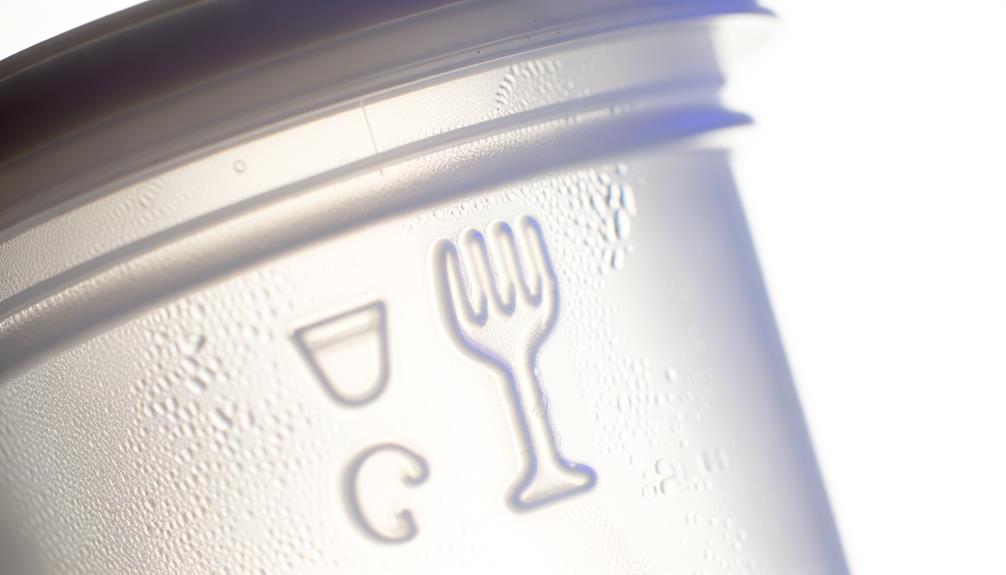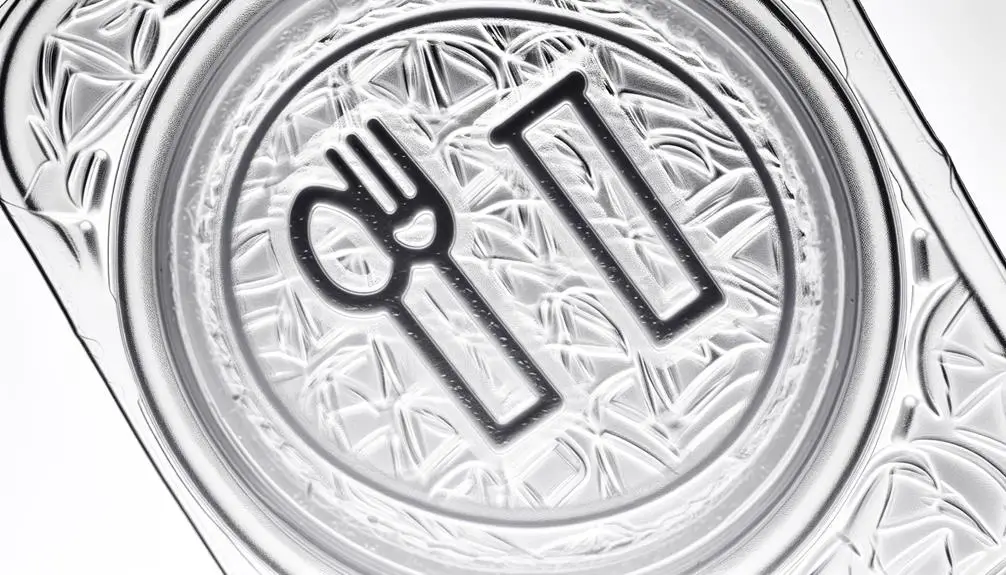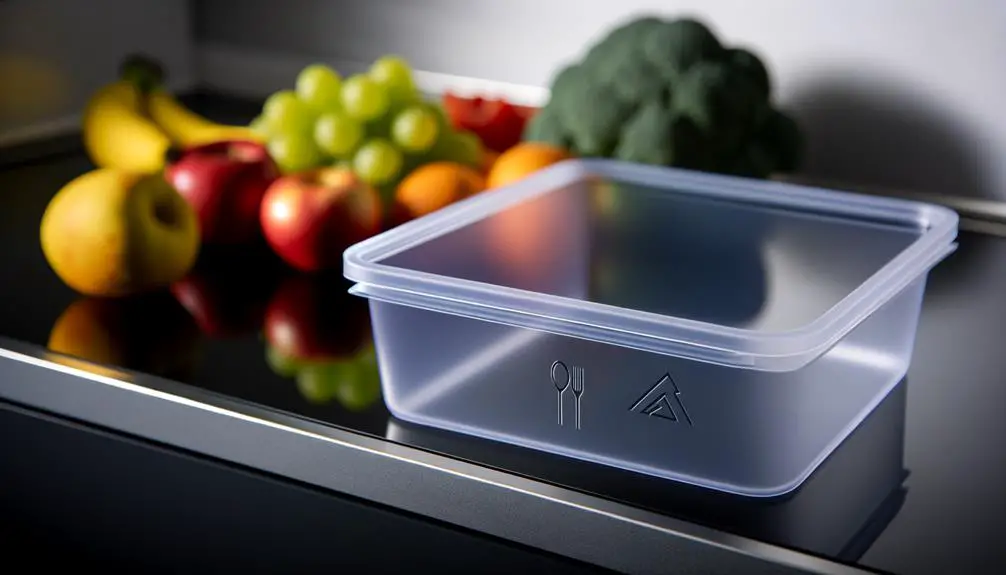Fork and Glass Symbol on Plastic: What Is Its Meaning?
The fork and glass symbol on plastic indicates the material is safe for food contact, adhering to stringent safety regulations such as the EU's Regulation (EC) No 1935/2004. This symbol assures consumers that the plastic has undergone rigorous testing, including migration tests to assess chemical transfer.
It helps prevent harmful chemicals from contaminating food, thereby reducing health risks associated with plastic contaminants. The symbol is essential for international compliance with food safety standards, ensuring trust in food storage and preparation items.
For more detailed insights into these regulatory frameworks and safety tips, explore further information available.

Key Takeaways
- Indicates the plastic is safe for food contact under specific conditions.
- Ensures compliance with stringent safety and health regulations.
- Represents testing to prevent harmful chemical transfer to food.
- Guarantees the material meets international food safety standards.
- Does not imply suitability for microwave or dishwasher use.
Symbol Overview

The fork and glass symbol on plastic products signifies that the material is deemed safe for contact with food and beverages. This emblem, governed by standards such as the European Union's Regulation (EC) No 1935/2004, indicates compliance with stringent safety criteria.
Manufacturers must verify that plastics bearing this symbol do not release harmful substances into consumables. The symbol also represents that the product has been tested under specified conditions that simulate actual use scenarios. This regulatory measure encompasses various testing protocols, including migration tests, which assess the extent of chemical transfer from plastic to food.
Hence, the presence of the fork and glass icon serves as a reliable indicator, guaranteeing that the consumer's health and safety are prioritized in food-related applications.
Importance for Food Safety
Making sure food safety is paramount, and the fork and glass symbol on plastic plays a crucial role in minimizing health risks associated with plastic contaminants. This symbol signifies that the plastic material is safe for contact with food, reducing the likelihood of chemical leaching and contamination. The importance of this symbol can be broken down as follows:
| Aspect | Importance |
|---|---|
| Chemical Safety | Prevents harmful chemicals from contaminating food |
| Consumer Confidence | Guarantees trust in food storage and preparation items |
| Compliance with Safety Norms | Adheres to industry standards for food-grade materials |
Regulatory Standards

Regulatory standards governing the use of the fork and glass symbol on plastic are essential to ensuring international compliance with food safety and health standards. These regulations also consider the environmental impact of plastic materials used in food contact applications.
Compliance with these standards is vital for manufacturers to meet both legal requirements and consumer expectations globally.
International Compliance Requirements
Understanding international compliance requirements for the fork and glass symbol on plastic necessitates a thorough examination of various regulatory standards across different countries. Regulatory bodies such as the European Union (EU), the United States Food and Drug Administration (FDA), and other national agencies establish guidelines to guarantee consumer safety. These standards dictate the permissible materials and manufacturing processes for plastics that come into contact with food.
| Region | Regulatory Body | Key Regulation |
|---|---|---|
| European Union | EFSA | Regulation (EC) No 1935/2004 |
| United States | FDA | Code of Federal Regulations Title 21, Part 177 |
| Japan | MHLW | Food Sanitation Law Article 16 |
| Australia | FSANZ | Australia New Zealand Food Standards Code – Standard 1.4.1 |
Compliance with these regulations guarantees that plastics marked with the fork and glass symbol are safe for food contact use across diverse markets.
Safety and Health Standards
Adherence to safety and health standards is crucial in guaranteeing that plastics marked with the fork and glass symbol meet the strict regulatory criteria required for food contact materials. These standards, established by organizations such as the U.S. Food and Drug Administration (FDA) and the European Food Safety Authority (EFSA), mandate rigorous testing for chemical migration, toxicity, and overall material integrity.
Compliance ensures that substances potentially harmful to human health do not leach into food and beverages. Additionally, manufacturers must maintain meticulous documentation and undergo periodic inspections to verify ongoing adherence. This regulatory oversight is essential for consumer protection, providing assurance that the materials used in everyday food-related applications are safe and reliable.
Environmental Impact Regulations
Environmental impact regulations play an essential role in securing the sustainable production and disposal of plastics marked with the fork and glass symbol. These regulations mandate manufacturers to adhere to specific guidelines that minimize environmental harm. Compliance with directives such as the European Union's Packaging and Packaging Waste Directive ensures that materials used are recyclable and safe for food contact.
Additionally, regulations may include requirements for reducing hazardous substances, promoting the use of biodegradable plastics, and encouraging the recycling of packaging materials. By enforcing these standards, regulatory bodies aim to reduce the environmental footprint of plastic products, thereby protecting ecosystems and public health. Effective implementation and monitoring of these regulations are vital for achieving long-term sustainability goals.
Types of Plastic
Plastics are categorized into various types based on their chemical composition, physical properties, and intended use. Understanding these categories is essential for identifying their applications and potential safety concerns.
The primary types of plastic include:
- Polyethylene Terephthalate (PET): Commonly used in beverage bottles and food containers due to its strength and ability to contain carbonation.
- High-Density Polyethylene (HDPE): Utilized for milk jugs, detergent bottles, and other products requiring durability and resistance to impact.
- Polyvinyl Chloride (PVC): Found in plumbing pipes, medical devices, and cable insulation, valued for its versatility and chemical resistance.
- Low-Density Polyethylene (LDPE): Used for plastic bags, shrink wraps, and flexible lids, appreciated for its flexibility and low-cost production.
This classification framework aids in making informed decisions regarding plastic use and recycling.
Safe Usage Tips

Understanding the various types of plastic is crucial to guaranteeing their safe usage in everyday applications. To maximize safety, always check for the fork and glass symbol, which indicates food-grade quality.
Avoid using plastic containers marked with this symbol in high-temperature environments, such as microwaves or dishwashers, unless specifically labeled as microwave-safe or dishwasher-safe.
Confirm plastic items are free from cracks or significant wear, as these can harbor bacteria. Refrain from using plastic with the recycling code 3 (PVC) or 7 (other) for food storage, as they may contain harmful chemicals.
Always follow manufacturer guidelines regarding temperature limits and intended usage to prevent chemical leaching and maintain the integrity of the plastic.
Misconceptions
A common misconception is that the fork and glass symbol on plastic items indicates that they are safe for microwave use or dishwasher cleaning.
However, this symbol specifically denotes that the plastic is safe for food contact, not necessarily for exposure to high temperatures or mechanical washing.
Clarifying these distinctions is crucial to guarantee proper usage and maintenance of plastic products.
Safe for Microwaves
Many individuals mistakenly believe that the fork and glass symbol on plastic packaging indicates that the item is safe for microwave use. This misconception can lead to improper usage and potential hazards.
It is essential to understand that the fork and glass symbol solely signifies that the plastic is safe for contact with food. To determine if a plastic item is microwave-friendly, look for the specific microwave-friendly symbol, which usually includes wavy lines.
Here are common symbols to look for:
- Fork and Glass: Safe for food contact.
- Wavy Lines: Microwave-friendly.
- Snowflake: Freezer-safe.
- Dish Symbol: Dishwasher-safe.
Analyzing these symbols guarantees proper and safe usage of plastic items in various applications.
Dishwasher Friendly
Despite widespread belief, the presence of the fork and glass symbol on plastic does not necessarily mean the item is dishwasher-friendly. This symbol primarily indicates that the plastic is safe for food contact.
However, dishwasher safety depends on the material's resistance to high temperatures and harsh detergents used in dishwashers. Some plastics may warp, melt, or degrade when subjected to these conditions.
It is essential to look for additional markings, such as a dishwasher-safe icon, or refer to the manufacturer's guidelines to confirm the item can withstand dishwasher cycles. Misinterpreting these symbols could lead to damage or contamination, highlighting the importance of careful examination of all relevant packaging information.
Conclusion
In understanding the fork and glass symbol on plastic, the juxtaposition between consumer convenience and regulatory oversight becomes apparent. While the symbol guarantees that the plastic is safe for food contact, the complexity of regulatory standards and the variety of plastic types underscore the importance of informed usage.
Misconceptions surrounding the symbol can lead to misuse, emphasizing the necessity for continuous education. Ultimately, vigilance in adhering to safety guidelines guarantees the protection of public health.






